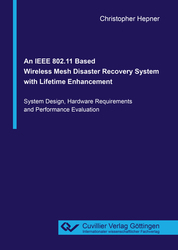| Departments | |
|---|---|
| Book Series (96) |
1378
|
| Nachhaltigkeit |
3
|
| Gesundheitswesen |
1
|
| Humanities |
2364
|
| Natural Sciences |
5406
|
| Engineering |
1793
|
| Engineering | 292 |
| Mechanical and process engineering | 862 |
| Electrical engineering | 686 |
| Mining and metallurgy | 30 |
| Architecture and civil engineering | 75 |
| Common |
98
|
|
Leitlinien Unfallchirurgie
5. Auflage bestellen |
|
Advanced Search
An IEEE 802.11 Based Wireless Mesh Disaster Recovery System with Lifetime Enhancement (English shop)
System Design, Hardware Requirements and Performance Evaluation
Christopher Hepner (Author)Preview
Table of Contents, PDF (38 KB)
Extract, PDF (520 KB)
After the occurrence of a disaster (e. g. an earthquake or tsunami) one of the main needs for the rescue teams and volunteer helpers is a functional communication infrastructure even during the first hours. The disaster recovery system (DRS) which is proposed in this work is based on an IEEE 802.11s wireless mesh network which is set up by non-damaged, legacy, mesh capable and battery powered devices still available in the disaster region. Key considerations concerning the performance of a DRS are the required node density, the coverage that can be achieved by a given node density, scalability as well as the lifetime of the system. For lifetime of the system. For lifetime enhancement, which is a key challenge for the proposed DRS on battery powered devices, a distributed algorithm is proposed which enhances the lifetime of such a system by an approach which allows to shut down non-necessary nodes and to keep them for a later usage while still keeping network connectivity.
| ISBN-13 (Hard Copy) | 9783736970526 |
| ISBN-13 (eBook) | 9783736960527 |
| Final Book Format | A5 |
| Language | English |
| Page Number | 248 |
| Lamination of Cover | matt |
| Edition | 1. |
| Publication Place | Göttingen |
| Place of Dissertation | Erlangen-Nürnberg |
| Publication Date | 2019-08-28 |
| General Categorization | Dissertation |
| Departments |
Electrical engineering
Telecommunications and communications engineering |
| Keywords | Erdbeben, Tsunami, Wireless Mesh Network, DRS, Monte-Carlo-Simulation, Recovery-Systeme, Connectivity, Energy Efficient Realization, Mesh capability |








